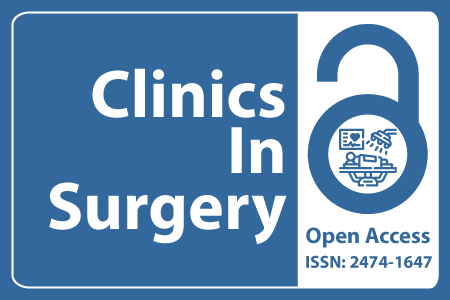
Journal Basic Info
- Impact Factor: 1.995**
- H-Index: 8
- ISSN: 2474-1647
- DOI: 10.25107/2474-1647
Major Scope
- Emergency Surgery
- Thoracic Surgery
- Orthopaedic Surgery
- Otolaryngology - Head and Neck Surgery
- Robotic Surgery
- Plastic Surgery
- Gastroenterological Surgery
- Surgical Oncology
Abstract
Citation: Clin Surg. 2022;7(1):3527.Research Article | Open Access
Bifurcation Resection and Interposition of a Polytetrafluoroethylene Graft (BRIG) as Primary Treatment for Carotid Artery Disease
Dries Dorpmans*, Nicolas De Hous, Ian Diebels and Philippe De Vleeschauwer
Department of Vascular Surgery, Heilig-Hartziekenhuis, Belgium
*Correspondance to: Dries Dorpmans
PDF Full Text DOI: 10.25107/2474-1647.3527
Abstract
Objective: Carotid Endarterectomy (CEA) is the gold standard for the treatment of symptomatic and high-grade asymptomatic carotid artery stenosis. Prosthetic carotid grafting is a safe alternative in technically challenging cases when CEA is hazardous. The objective of the present study was to evaluate an alternative surgical technique, the Bifurcation Resection and Interposition of a Polytetrafluorethylene Graft (BRIG) procedure, as a primary treatment for carotid artery disease. Methods: A retrospective study was performed on all patients that underwent a BRIG procedure at our institution (Heilig-Hartziekenhuis, Lier, Belgium) between January 2007 and October 2019. We investigated the postoperative morbidity (local complications, perioperative neurological complications, reinterventions and restenosis) and mortality associated with BRIG. The primary outcomes of the study were the perioperative stroke and mortality rates, and the long-term restenosis rates. Results: A total of 170 consecutive BRIG procedures were performed on 155 patients (mean age: 71 years). The median follow-up time was 37 months (Interquartile Range [IQR] 18-61, maximum 148). There were no deep surgical site or graft infections. The perioperative stroke and mortality rates were 1.8% and 0.6%, respectively. There were no major perioperative strokes. Early postoperative (minor) stroke occurred in three patients, of whom two had early graft thrombosis requiring urgent reintervention. One patient died in the early postoperative period due to an acute myocardial infarction. The overall postoperative restenosis rate was 8.2%. The median time to restenosis was 44 months (IQR 18-80). One- and five-year restenosis rates were 1.8% and 5.4%, respectively. Conclusion: The BRIG procedure is a valid alternative to CEA for the primary treatment of carotid artery disease. The simplified surgical technique allows for a shorter operating and clamping time, and seems to result in lower perioperative stroke and long-term restenosis rates when compared to CEA.
Keywords
Cite the article
Dorpmans D, De Hous N, Diebels I, De Vleeschauwer P. Bifurcation Resection and Interposition of a Polytetrafluoroethylene Graft (BRIG) as Primary Treatment for Carotid Artery Disease. Clin Surg. 2022; 7: 3527..













